Ijraset Journal For Research in Applied Science and Engineering Technology
- Home / Ijraset
- On This Page
- Abstract
- Introduction
- Conclusion
- References
- Copyright
Development of Android App on Scheduling Payments and Financial Management of Workers in Construction Industry
Authors: Abhishek Kumar, G Akshatha, Netravati V Moger, Mr. Roshan S Kotian
DOI Link: https://doi.org/10.22214/ijraset.2024.62285
Certificate: View Certificate
Abstract
A innovation centralized platform designed specifically for labour payment to efficiently manage project management, labour payments and generate detailed financial reports. Mobile computing offers helps to construction workers improve efficiency and minimize the paper works. However, the uptake of the technology is quite low in the industry, with little research on key constraint factors and the priority needs of the construction workforce. In recent year mobile applications have become increasingly popular years and is expected to continue like that as all the tech is moving towards mobile. However, unfortunately, in the face of accelerating user demand, businesses are not validating that their apps are safe, secure and they are more dragged by the speed-to-market pressure as well as the need to maintain a high level of user experience. As the application contains all the payment information tedious writing work can be avoided on site. Just set the payment in the application and are free to go. Extensive time and effort are spent on inspecting and documenting of payments. Managing large number of projects with various subcontractors will be difficult. If the hard copy is lost, entire data set cannot be taken back. In financial updates client also face same problem, to get clients according to their requirements. To bridge this gap and to develop better connection between client, engineers and subcontractors, we need a platform. Project cost based on labour payments and payments pending can be accessed easily. Maintain a history of project payments, weekly payments balance payments tracker.
Introduction
I. INTRODUCTION
In the construction industry, extensive time and efforts are spent on inspecting and documenting. When a building project is almost completed, project parties conduct site inspections to prepare punch lists. This project discusses an approach to provide clients, engineers and contracts a stable and weekly recording of payments to access the information about daily records in construction site. This helps in preventing delays and enhancing overall project coordination. The payment module facilitates seamless financial transactions within the app, providing a secure and transparent platform for clients and contractors to known about payments. This android app empowers construction professionals to work more efficiently, reduce paperwork and minimize errors. The app's intuitive design and user-friendly interface make it accessible to a wide range of users from project managers. This level of transparency and communication contributes to a more collaborative and productive working environment. Mobile applications development with android technologies and algorithms presents advanced techniques for mobile app development and addresses recent developments in mobile technologies and wireless networks. The first section describes mobile app design and development skills. Evaluate the effectiveness of android apps compared to traditional labour payment methods. Introduce the importance of labour payments in construction and the role of technology.
A. Data collection
This project is based on a survey designed to gather all necessary information of labour payment in and around Udupi region. To study of labour payments in various methods within the region of Udupi district, to collect required data from different places. During data collection we understood that managing large number of projects with various subcontractors will be difficult. If the hard copy is lost, entire data set cannot be taken back. In other words, client also face same problem, to their requirements. To solve this problem. We came up with easy and relevant solution which will allow labour payments tracking and management, improve accuracy and accountability, efficient scheduling and simplicity. Which would give us major inputs like name of the project, client details, location of project, estimated cost and payment status and multi projects can easily handled with various subcontractors.
B. Application Development
After collecting data, it will be feed in mobile application, which is developed using coding language. In this app client will get in essential information about labour, also engineers get the information about the labour payments, project tracking. This app is user friendly, used for multi projects.
C. Objectives
- Studying the existing method of scheduling payments to labour, contractors and Subcontractor.
- To develop the simplified method of scheduling payments and developing the android app.
- Testing of app in construction industry around Udupi region.
II. STUDY AREA
A. Studying The Existing Method Of Scheduling Payments
In construction industry involves examining various approaches used by contractors, subcontractors and clients to manage cash flows and ensure timely disbursements. This typically includes analysing payments terms, milestone, invoicing processes and any legal or regulatory requirements that may impact payment schedules. Additionally, factors such as project complexity, cash flow management and regulatory requirements are considered in such studies to propose improvements or best practices for payment scheduling in construction projects.
B. Conduction Of Construction Labour Payment Survey In Various Location
A labour payment survey is conducted within a region of Udupi district to collect labour payment information. In this place most commonly excel spreadsheets and voucher systems are used. Construction industry involves examining various approaches used by contractors, subcontractors and clients to manage cash flows and ensure timely disbursements. This typically includes analysing payments terms, milestone, invoicing processes and any legal or regulatory requirements that may impact payment schedules. Additionally, factors such as project complexity, cash flow management and regulatory requirements are considered in such studies to propose improvements or best practices for payment scheduling in construction projects.
C. Excel Spreadsheet
Excel spreadsheets are used in civil engineering to organise and manage project data, perform calculations and analysis, create graphical representations of data and optimised project performance. Also it is used for cost estimation, scheduling and design calculations.
While excel sheets offer flexibility and familiarity for managing labour payments in construction industries, they also come with certain limitations and disadvantages, especially as the scale and complexity of construction projects increase. Here are some disadvantages of relying only on excel sheets for labour payments in construction. excel sheets can become unwieldy and inefficient when managing large volumes of labour data across multiple projects or with numerous employees.
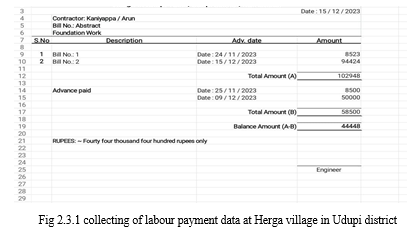
D. Voucher Payment Systems
Payment vouchers can be used to record payments of cash or cheques. It includes important information about each party involved in a transaction and creates an auditable papers trail about checks payments. Any written documentation supporting the entries reported in the account books, indicating the transaction accounting accuracy, can be referred as a voucher.
For example: A bill, invoice receipts salary and wages sheet, cheque book etc
The voucher system, often used for labour payments in construction industries, can have several disadvantages that may impact efficiency, transparency, and control over payments. The voucher system requires creating and managing individual vouchers for each labour payment transaction, which can be labour-intensive and time-consuming. Administrators or finance teams must handle the paperwork associated with issuing and reconciling vouchers, leading to increased administrative overhead. Handling vouchers by hand raises the possibility of mistakes.
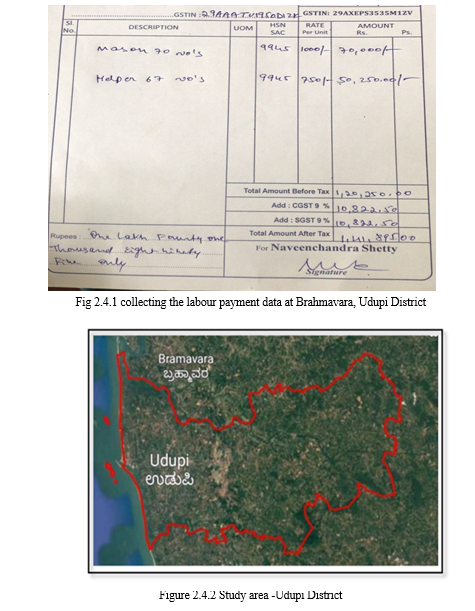
III. METHODOLOGY

A. Literature Survey
To identify and compare existing test estimation techniques for traditional software and for mobile software. A literature survey on labour payments in the construction industry within the context of android applications involves exploring how technology, specifically mobile apps, is being utilized to manage and streamline labour payments in construction settings. Here's a structured approach to conducting this literature survey android apps specifically designed for labour management, payroll, or payment processing in construction. Look for peer-reviewed articles and conference papers on technology adoption in construction labour management. Identify android apps designed for labour payments and their functionalities. Examine user feedback and case studies on the implementation of these apps. Understand the advantages and limitations of using mobile apps for labour payments in construction. Determine the extent of adoption of mobile apps for labour payments in construction. Present the evolution of mobile technology in construction labour management. Group literature by themes such as app features, impact on efficiency, regulatory compliance, etc
B. Study Of Existing Method Of Scheduling Of Payments
Involves examining how payments are currently planned and organized within the system. Studying existing methods of scheduling payments in the construction industry involves examining how contractors, subcontractors and clients manage and schedule payment processes throughout a construction project. Focus on payment scheduling methods used in construction projects. Understand traditional payment scheduling methods. Examine methods where payments are tied to the completion percentage of specific project tasks. Study how retentions (holdbacks) and final payments are managed at project completion. Discuss how payment scheduling impacts cash flow for contractors and subcontractors. Recognise the laws in our area and industry standards influencing payment scheduling. Include real-world examples or case studies to illustrate effective payment scheduling practices. By conducting a comprehensive study of existing methods of scheduling payments in construction industries, you can contribute valuable insights to the field and identify opportunities for improvement through technology adoption and best practices implementation
C. Developing A Simple Payments Method For Handling Multiple Project
Developing a simple payment method for handling multiple projects in android app for the construction industry involves designing a user-friendly interface and incorporating secure payment processing functionalities. Display transaction history and payment status for each work. Encrypt sensitive payment information to ensure security.
Identify and address any issues related to payment processing or user experience. Design the payment system to handle a growing number of transactions. Allow customization of payment terms and methods based on project requirements. By following these steps and considerations, you can develop a robust and user-friendly payment method in the android app tailored for handling multiple projects in the construction industry. This approach focuses on enhancing efficiency, security, and transparency in labour payments, ultimately contributing to improved project management.
D. Developing Android App In Which Multiple Projects Can Be Handled
Establishing a central platform for project input projects expenses, track payments, generate financial reports. Developing an android app to manage multiple projects in construction industry requires careful planning and consideration of the specific needs and workflows of project. Allow to create, view, and simultaneously manage multiple projects. Enable assignment tasks to team members or subcontractors within each project. Facilitate document sharing and collaboration. Provide insights into project progress, timelines and resource allocation. Design a user-friendly interface with easy navigation between projects and tasks.
E. Testing Of App In Construction Industry
Testing an app in involves assessing its functionality, usability and performance. Testing an android app designed for labour payments in the construction industry requires a structured approach to ensure functionality, usability, security, and reliability. Given the critical nature of labour payments and the unique requirements of the construction sector. Verify that labour payments are accurately calculated and processed based on different parameters. Test the app across various android devices (phones and tablets) and screen sizes. Ensure compatibility with different Android Operating System versions. Verify that data remains consistent and accurate across different app functionalities. Ensure compliance with relevant payment processing regulations. verify compliance with data protection laws regarding user data handling and storage. By following these testing strategies and considerations, you can ensure that your android app for labour payments in construction industry meets the quality standards required for reliable and secure operation in real-world construction project environments. Regular testing and continuous improvement based on feedback well contribute to a successful and effective app deployment.
F. To Develop The Simplified Method Of Scheduling Payments And Developing The Android App
In today’s dynamic work environments, efficient labour payment is crucial for success. To address the challenges of tracking and analysing labour data effectively, we are excited to introduce our new android app designed specifically for this purpose. Our app aims to streamline the process of collecting, organizing and analysing labour payment related information. Whether you’re managing a construction site, a manufacturing plant, or any other labour-intensive operation, this app provides a user-friendly interface to gather vital data and derive actionable insights. Our labour payment app is a revolutionary tool designed to simplify and streamline the process of managing labour compensation. Developed with the needs of engineers, client and contractors in mind, this app offers a seamless solution for handling payroll and ensuring timely payments.
- Enhance operational efficiency through better labour management.
- Identify areas for improvement and optimize labour workflows.
- Reduce administrative overhead with automated data collection and reporting.
- Improve communication and coordination among team members.
G. Developing The Android App
A innovative centralized platform designed specifically for consultants to efficiently manage project management, labour payments and generate detailed financial reports. Our goal is to provide easy application to clint, engineers and subcontractors with the tools they need to streamline financial operations and gain valuable insights into project finances. In today's digital age, secure login systems are fundamental to protecting user data and ensuring personalized experiences within applications. Our login functionality plays a crucial role in providing secure access to their project data and features within our centralized platform.
1. Key Features of Our Platform
- Expense Input: Consultants can easily input project related labour payments directly into the platform.
- Payment Tracking: Monitor payment statuses, track receivables and stay updated on project financials in real-time.
- Financial Reporting: Generate comprehensive financial reports and client-specific reports.
- Centralized Data Storage: Access project financial data securely in one centralized location, facilitating efficient collaboration and payment data management.
- Customizable Dashboards: Customize dashboards to display key financial metrics and project-specific insights.
2. Benefits of Our Platform
- Increase efficiency by eliminating manual processes and paperwork associated with expense tracking.
- Enhance financial visibility and control over project budgets and Labour payment expenditures.
- Improve accuracy and timeliness of financial reporting to clients.
- Streamline communication and collaboration with clients regarding project finances.
3. How Our Platform Works
Sign Up: Consultants can register and create an account on our platform.
Project Setup: Create and set up project profiles, including budget details and client information.
Expense Input: Input project expenses as they occur, categorizing them for accurate tracking.
Payment Monitoring: labour payments received and outstanding, ensuring timely invoicing and collections.
Report Generation: Generate customized financial reports to analyse project performance and financial health.
a) Get Started
"Get Started" app on android is designed to assist users in initiating and organizing tasks, projects, or activities efficiently. It focuses on overcoming procrastination and providing a structured approach to beginning new endeavours. Upon launching the app, users can create a personalized account or sign in with existing credentials. Users can create new projects or tasks by providing a title, description, and associated category (e.g., Name, Email, Password, Conform password). For every project or task, users can create detailed task lists or checklists outlining the specific actions needed to get started. The app offers guided steps or prompts to assist users in initiating their projects. Ensuring user data privacy and security through encrypted storage.
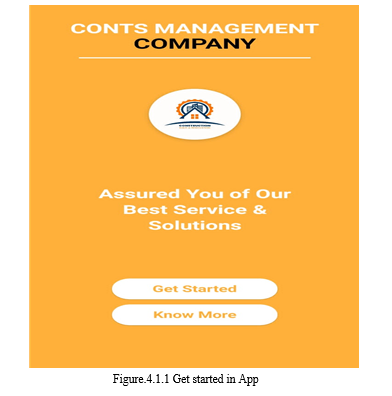
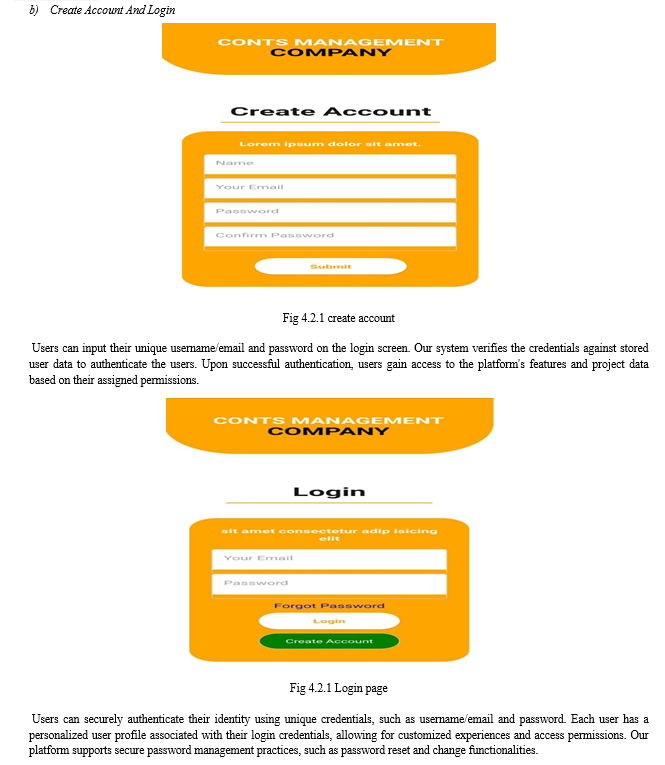

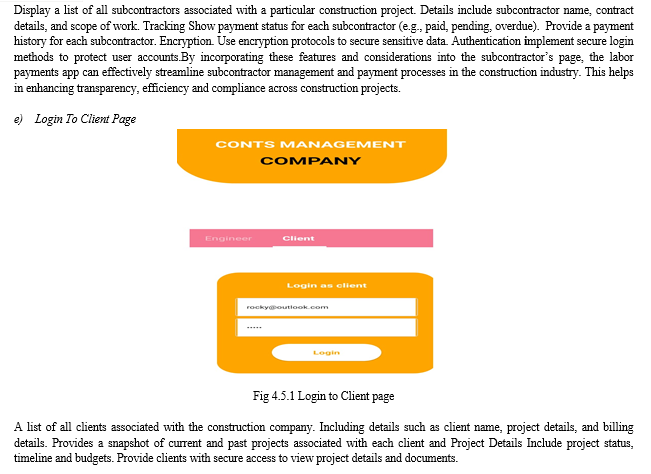
IV. TESTING OF APP IN CONSTRUCTION INDUSTRY
Testing an android app designed for labour payments in the construction industry requires a structured approach to ensure functionality, usability, security and reliability. Given the critical nature of labour payments and the unique requirements of the construction sector. Verify that labour payments are accurately calculated and processed based on different parameters. Test login/logout functionalities, ensuring secure access to authorized users only. Validate the assignment and tracking of labour tasks within projects. Evaluate the app's ease of use, intuitiveness, and consistency in design elements. Ensure smooth workflows for users and project managers. Check for accessibility features to accommodate users with disabilities. Measure app response times for critical actions like processing payments or accessing project details.
A. Advantages of Labour payment app
- Convenience: An Android app for labour payment offers convenience and accessibility. Engineers and clients can view payment details directly from their mobile devices without the need to access a computer or visit the office.
- Time Efficiency: With a labour payment app, employers can streamline the payment process. They can quickly review and approve timesheets, calculate wages, and initiate payments directly through the app, saving time and reducing administrative overhead.
- Cost-Effective: Using an android app for labour payment can be cost-effective compared to traditional paper-based methods or legacy payroll systems. It reduces printing and distribution costs associated with pay checks and paperwork
- Scalability: Android apps can scale to accommodate the growing needs of businesses, from startups to large enterprises. They can handle various numbers of subcontractors and payroll complexities, adapting to organizational growth.
V. SCOPE FOR FUTURE WORK
- Development and updating of this app should be done frequently for fixing the problems and introducing new features to users.
- Total project cost can be provided in this app.
VI. ACKNOWLEDGMENTS
We sincerely acknowledge our heartfelt gratitude and sincere pranamas to H.H. Shri Vishwavallabha Theertha Swamiji for his blessings to this institution.
We express our deepest gratitude and respect to our guide Mr. Roshan S Kotian Assistant Professor, Department of Civil Engineering, for his valuable guidance and encouragement while doing this project work.
We are indebted to Prof. Dr. Thirumaleshwara Bhat, Principal and Prof. Dr. Ganesh Aithal, Vice Principal, for their advice and suggestions at various stages of the work. We also extend our heartfelt gratitude to Dr. Deepika B V associate professor and HOD Department of Civil Engineering for her assistance.
We also extend our heartfelt gratitude to our project co Ordinator Mr. Sunil S Haldankar, Assistant Professor for his assistance.
We are very thankful to Mr. Amarjeet Kumar, Department of CSE who had assisted us development of android app. We are also grateful to the society for helping us to collect the labour payments data from the construction site.
We extend our thanks to the Management of Shri Madhwa Vadiraja Institute of Technology and Management, Bantakal, Udupi for providing good laboratory and library facilities. We also remain grateful to the co-operation and help rendered by the teaching and non-teaching staff of the Civil Engineering Department.
Lastly, we take this opportunity to offer our regards to all of those who have supported us directly or indirectly in the successful completion of this project work.
Conclusion
A innovative centralized platform designed specifically for labour payment to efficiently manage project management, labour payments and generate detailed financial reports. In today\'s digital age, secure login systems are fundamental to protecting user data and ensuring personalized experiences within applications. Our ability to login is essential to giving users safe access to their projects data and features within our centralized platform. Developing an android app which is tailored for the construction industry and helpful for scheduling and payments. It provides a secure and transparent platform for clients and contractors to manage payments. Our app is user friendly, basic knowledge is enough to use this app. Android apps can scale to accommodate the growing needs of business, from startups to large enterprises. They can handle various number of subcontractors and payroll complexities, adapting to organizational growth. An android app for labour payment offers convenience and accessibility. Engineers and clients can view payment details directly from their mobile devices without the need of computer or visit the office. Using an android app for labour payment can be cost-effective compared to traditional paper-based methods or legacy payroll systems. It reduces printing and distribute costs associated with pay checks and paperwork. Eliminates manual paperwork and reduces the risk of errors associated with manual data entry. Automated calculations ensure accurate payment processing, reducing disputes and delays.
References
[1] Salma Azhar, Andrew Jackson, Anoop Sattineni Auburn University DOI 10.22260/ISARC2015/0008(June 2005) proposed construction Apps:” A Critical Review and Analysis. [2] Chen Y et.al., Automation in construction, proposed “A Framework for using Mobile Computing for information Management on Construction sites” vol no. 20 (7). Pg:776-788. (2008). [3] Venkatraman, S., and Yoong, P. “Role of mobile technology in the construction industry - A case study” International journal of Business Information Systems vol no. 4(2), Pg:195-209. (2009). [4] Banihashemi, S., Hosseini, M. R., Golizadeh, H., & Sankaran, S. (2017). “Critical success factors (CSFs) for integration of sustainability into construction project management practices in developing countries”. International Journal of Project Management, 35(6), 1103-1119. [5] Bargat, Komal Dipak, and Ajay P. Shelorkar. \"Development, Implementation and Comparison of Mobile Application with Traditional Method for Scheduling on Construction Site-Project Masterplan.\" (2021). [6] Camacho, D. D., Clayton, P., O\'Brien, W. J., Seepersad, C., Juenger, M., Ferron, R.,Salamone, S. (2018). “Applications of additive manufacturing in the construction industry–A forward-looking review. Automation in Construction,” 89, 110-119. [7] Nguyen, Long D., Anna Koufakou, and Colin Mitchell. \"A smart mobile app for site inspection and documentation.\" (2015). [8] Sudarshan Kamraj, SRM institute of technology of science and technology ISSN: 2455-4847(July 2019) proposed a “Study on the Development of a mobile application for the ease of communication for construction site management.” [9] Xu, Sheng, and Hanbin Luo. \"The information-related time loss on construction sites: a case study on two sites”. International Journal of Advanced Robotic System 11, no. 8 (2014): 128. [10] Chen, Y., McCabe, B., & Hyatt, D. (2017). “Impact of individual resilience and safety climate on safety performance and psychological stress of construction workers”: A case study of the Ontario construction industry. Journal of Safety Research, 61, 167-176.
Copyright
Copyright © 2024 Abhishek Kumar, G Akshatha, Netravati V Moger, Mr. Roshan S Kotian. This is an open access article distributed under the Creative Commons Attribution License, which permits unrestricted use, distribution, and reproduction in any medium, provided the original work is properly cited.

Download Paper
Paper Id : IJRASET62285
Publish Date : 2024-05-17
ISSN : 2321-9653
Publisher Name : IJRASET
DOI Link : Click Here
 Submit Paper Online
Submit Paper Online

